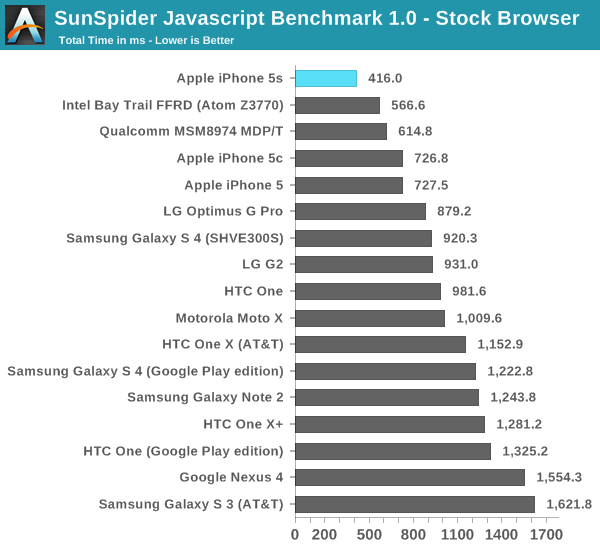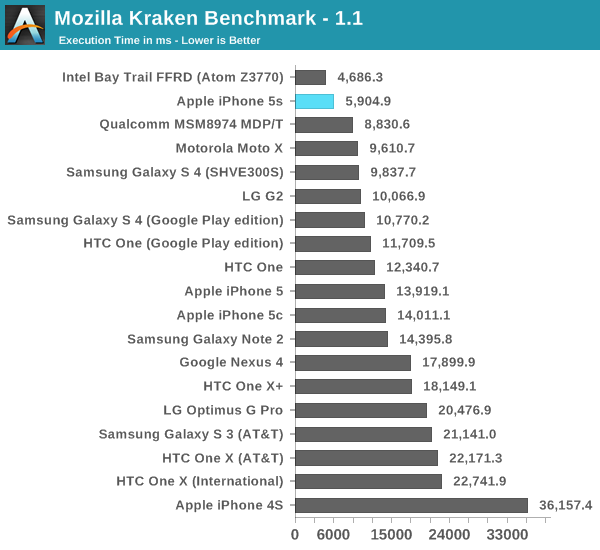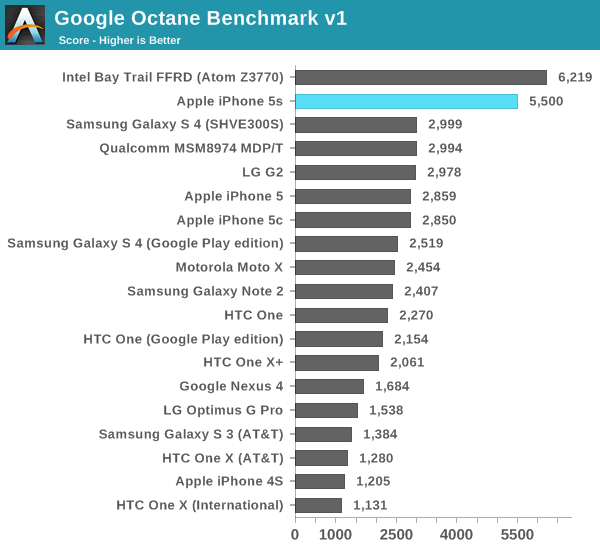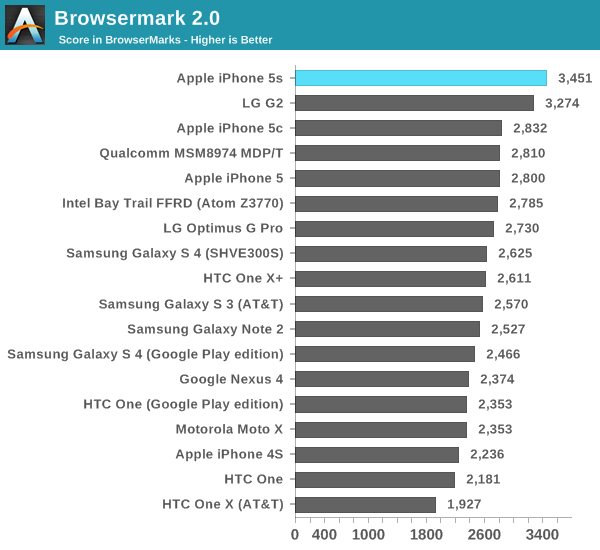The iPhone 5s Review
by Anand Lal Shimpi on September 17, 2013 9:01 PM EST- Posted in
- Smartphones
- Apple
- Mobile
- iPhone
- iPhone 5S
CPU Performance
For our cross-platform CPU performance tests we turn to the usual collection of Javascript and HTML5 based browser tests. Most of our comparison targets here are smartphones with two exceptions: Intel's Bay Trail FFRD and Qualcomm's MSM8974 Snapdragon 800 MDP/T. Both of those platforms are test tablets, leveraging higher TDP silicon in a tablet form factor. The gap between the TDP of Apple's A7 and those two SoCs isn't huge, but there is a gap. I only include those platforms as a reference point. As you're about to see, the work that Apple has put into the A7 makes the iPhone 5s performance competitive with both. In many cases the A7 delivers better performance than one or both of them. A truly competitive A7 here also gives an early indication of the baseline to expect from the next-generation iPad.
We start with SunSpider's latest iteration, measuring the performance of the browser's js engine as well as the underlying hardware. It's possible to get good performance gains by exploiting advantages in both hardware and software here. As of late SunSpider has turned into a bit of a serious optimization target for all browser and hardware vendors, but it can be a good measure of an improving memory subsystem assuming the software doesn't get in the way of the hardware.

Bay Trail's performance crown lasted all of a week, and even less than that if you count when we actually ran this benchmark. The dual-core A7 is now the fastest SoC we've tested under SunSpider, even outpacing Qualcomm's Snapdragon 800 and ARM's Cortex A15. Apple doesn't quite hit the 2x increase in CPU performance here, but it's very close at a 75% perf increase compared to the iPhone 5. Update: Intel responded with a Bay Trail run under IE11, which comes in at 329.6 ms.
Next up is Kraken, a heavier js benchmark designed to stress more forward looking algorithms. Once again we run the risk of the benchmark becoming an optimization target, but in the case of Kraken I haven't seen too much attention paid to it. I hope it continues to fly under the radar as I've liked it as a benchmark thus far.

The A7 falls second only to Intel's Atom Z3770. Although I haven't yet published these results, the 5s performs very similarly to an Atom Z3740 - a more modestly clocked Bay Trail SKU from Intel. Given the relatively low CPU frequency I'm not at all surprised that the A7 can't compete with the fastest Bay Trail but instead is better matched for a middle of the road SKU. Either way, A7's performance here is downright amazing. Once again there's a performance advantage over Snapdragon 800 and Cortex A15, both running at much higher peak frequencies (and likely higher power levels too, although that's speculation until we can tear down an S800 platform and a 5s to compare).
Compared to the iPhone 5, the 5s shows up at over 2.3x the speed of last year's flagship.
Next up is Google's Octane benchmark, yet another js test but this time really used as a design target for Google's own V8 js engine. Devices that can run Chrome tend to do the best here, potentially putting the 5s at a disadvantage.

Bay Trail takes the lead here once again, but again I expect the Z3740 to be a closer match for the A7 in the 5s at least (it remains to be seen how high the iPad 5 version of Cyclone will be clocked). The performance advantage over the iPhone 5 is a staggering 92%, and obviously there are big gains over all of the competing ARM based CPU architectures. Apple is benefitting slightly from Mobile Safari being a 64-bit binary, however I don't know if it's actually getting any benefit other than access to increased register space.
Our final browser test is arguably the most interesting. Rather than focusing on js code snippets, Browsermark 2.0 attempts to be a more holistic browser benchmark. The result is much less peaky performance and a better view at the sort of moderate gains you'd see in actual usage.

There's a fair amount of clustering around 2500 with very little differentiation between a lot of the devices. The unique standouts are the Snapdragon 800 based G2 from LG, and of course the iPhone 5s. Here we see the most modest example of the A7's performance superiority at roughly 25% better than the iPhone 5. Not to understate the performance of the iPhone 5s, but depending on workload you'll see a wide range of performance improvements.










464 Comments
View All Comments
robinthakur - Wednesday, September 18, 2013 - link
Agreed, the screen on my old galaxy 3 was awful enough for me to dump it and get a iPhone 5. Weird bluey-green tinting, incredibly fuzzy text, unreadable in sunlight and over saturation. The trick with turning on only the active pixels is a nice one, but I'd still rather have an accurately calibrated screen that doesn't present content incorrectly.Gorgenapper - Wednesday, September 18, 2013 - link
This was the reason why I passed on the Galaxy S3, even though a lot of review sites were touting it as having super crisp images and text, eye popping colors, and so on. I saw a demo unit in person, and the screen was simply not comparable to that of my iPhone 4S. Skin tones were orange on the GS3, yellow images were greenish, and through all of it I could notice the pixellation from the pentile arrangement of the LEDs. Also, the demo unit had screen burn in after only a week despite the display changing every second or so, while the demo units for the iPhones were still going strong and bright. AMOLED is crap, give me LCD any day.robinthakur - Wednesday, September 18, 2013 - link
You aren't comparing like with like though. The people who want a crazy 41MP feature phone with a camera that juts out of the back (meaning it won't lie flat) are not the same ones that want a premium iPhone. In truth, I don't think there will be a big demand for it. Yes I'm sure that the picture performance on a 1020 would absolutely wipe the floor with the camera in the 5S, but I would never consider buying one because it looks ugly and impractical and harkens back to the bad old days of phone design where function bested form IMO!KeypoX - Wednesday, September 18, 2013 - link
Apple's biggest advantage is being a second mover. Not a first. They have never been first in anything.Not first in:
Touch screen device/phone
App store
Tablet
Finger print reader
High res screens
The biggest advantage is they are SECOND movers and take these devices to the next level.
dugbug - Wednesday, September 18, 2013 - link
Panties in a bunch? WTF is up with people and apple.Gridlock - Wednesday, September 18, 2013 - link
The Newton alone makes most of your arguments laughable.André - Wednesday, September 18, 2013 - link
The iPhone 4 was the first phone to ship with more than 300 ppi screen 960 x 640 3,5".They were the first with FireWire, USB, Thunderbolt, DisplayPort and shipping a product with an PCIe SSD.
First to ship a device with an Rogue implementation and going with a fully custom ARMv8 64-bit processor.
If anything, they are not second movers and because they are so vertically integrated they can control both hardware and software.
code65536 - Wednesday, September 18, 2013 - link
So is it safe to assume the A7 has an out-of-order execution core?ViRGE - Wednesday, September 18, 2013 - link
Swift was already OOE.tipoo - Wednesday, September 18, 2013 - link
A6/Swift already did. A7 may be more out of order, it's not an all or nothing thing.